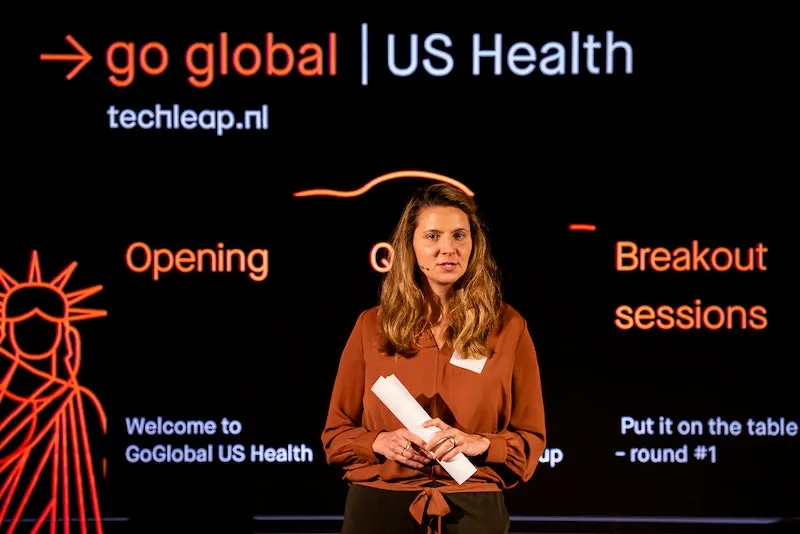December 8, 2021
Scaling your healthtech business to the US: here’s how you can make it a success

Overview:
These were some of the questions addressed by founders during the GoGlobal US Health launch event. Did you miss the event? No worries! In this article, you’ll find our detailed summary of the core takeaways of the Q&A session with Jamie Heywood, moderated by Sarah van Hellenberg Hubar-Fisher, as well as of the in-depth breakout sessions with internationalisation experts such as Willem Houck, Hans Constandt, and Dan Clark. Those discussions were further grouped by topics such as: hiring, securing investment, outlining a market-entry strategy, overcoming regulatory hurdles.
Jamie Heywood, Founder of Alden Scientific
Jamie Heywood – “There are essentially two classes of mistakes that I’ve made as an entrepreneur: strategic and execution mistakes. I think to be successful in healthcare, you really need to commit to what you believe is your strategic point of success. And a lot of companies tend to alter their core values as they try to generate revenue. So they start working on solutions they don’t really believe in, just to be profitable.
One of my strategic mistakes involved shortening the product development cycle in the interest of meeting our revenue objective. And then you’re stuck in this process because your efforts are not in line with your core value proposition. So trust your core value proposition and stick to it.
On the execution side, my greatest mistake was to not benchmark what success is for the team. I made the mistake of telling the team what I want to do instead of what I want to achieve, i.e. the objective I want to hit with this project.
In the marketplace, you understand your solutions’ strengths and weaknesses better than your customer and you have more interest in making sure it addresses their needs. So focus on what your customers’ problem actually is, and not what they tell you their problem is.
Next, Jamie Heywood points out the difficulty of breaking down the US healthtech opportunities geographically, since some of the states are very similar. However, there are clearly different markets you can target. This way, companies should look at innovation in terms of the structure of systems. According to Heywood, “a lot of innovation comes from Keizer or other integrated care provider systems, and these are not necessarily coast-based institutions. I like to think of it, specifically when it comes to transformative change, as a ‘doughnut-hole’ model.
The center of the doughnut hole encompasses the top institutions that do a lot of innovation. If you manage to become part of that system, then they often capture what you are providing rather than enabling you. They are also harder to work with, in general, as they have a lot of internal innovation and more opaque economics. Around that doughnut, there are those secondary healthcare institutions with very good talent, that desire innovation, but with fewer investments and grants provided by the government funding. Those institutions, if you provide a good solution, can combine and strengthen their offerings to try to compete with those from the center of the doughnut hole. This will drive your growth.
As for the rest, you will see fragmented health institutions in the US that have little structure, they scale slowly, are small, and have less economics to share.
I think for Europeans it’s hard to understand just how fractured the US healthcare system really is. Bluntly in the US if you are not making someone money, you are not doing business. And to understand that, you need to get a clear idea of how people are making money in the US.
It’s particularly important to know how the person/team you are targeting makes money, how they make profits, in order to be able to build solutions that will be adopted at a large scale. Many people will try innovation, but nobody is going to scale resources if your solution does not put a particular department in a favorable position compared to other systems.”
Some extra takeaways on this topic from the breakout discussions:
The US provides a massive single-language market potential. I don’t think it’s about regional variation but about where the leading research centers are. Boston, NYC, and Silicon Valley are big and hard-to-enter healthtech markets.
How to enter the US market in a different manner than direct?
Jamie Heywood: “Let’s take a solution space like disease management and you have a programme that demonstrates that a combination of clinician tools and technology improve the costs, or optimise production. There are market access points in the US that can be considered less obvious. For example, there are events where health benefit managers or top US health companies would meet and look for the latest innovations. And this is where I’ve seen instances of the most successful early adoption of companies’ solutions is driven by these groups.

 What the Atomico State of European Tech 2021 report means for the Dutch tech...
Scroll to top
What the Atomico State of European Tech 2021 report means for the Dutch tech...
Scroll to top